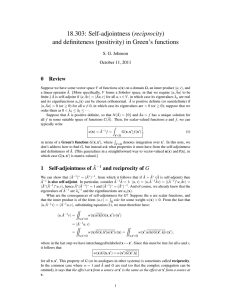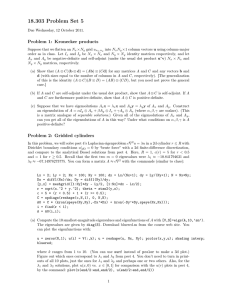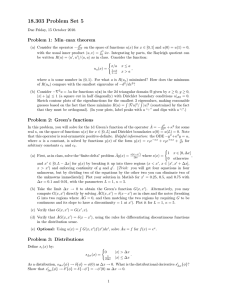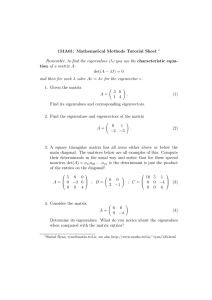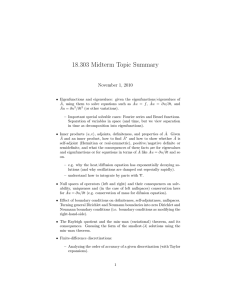18.303: Self-adjointness (reciprocity) and definiteness (positivity) in Green’s functions 0 Review
advertisement
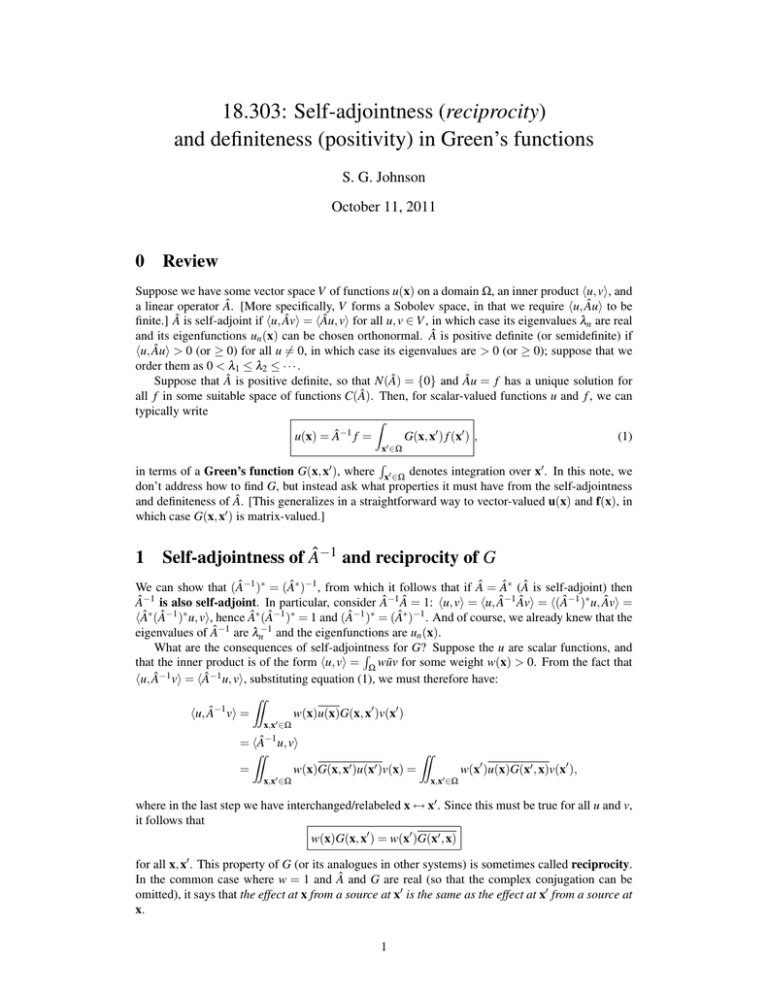
18.303: Self-adjointness (reciprocity)
and definiteness (positivity) in Green’s functions
S. G. Johnson
October 11, 2011
0
Review
Suppose we have some vector space V of functions u(x) on a domain Ω, an inner product hu, vi, and
a linear operator Â. [More specifically, V forms a Sobolev space, in that we require hu, Âui to be
finite.] Â is self-adjoint if hu, Âvi = hÂu, vi for all u, v ∈ V , in which case its eigenvalues λn are real
and its eigenfunctions un (x) can be chosen orthonormal. Â is positive definite (or semidefinite) if
hu, Âui > 0 (or ≥ 0) for all u 6= 0, in which case its eigenvalues are > 0 (or ≥ 0); suppose that we
order them as 0 < λ1 ≤ λ2 ≤ · · · .
Suppose that  is positive definite, so that N(Â) = {0} and Âu = f has a unique solution for
all f in some suitable space of functions C(Â). Then, for scalar-valued functions u and f , we can
typically write
ˆ
u(x) = Â−1 f =
G(x, x0 ) f (x0 ) ,
(1)
x0 ∈Ω
´
in terms of a Green’s function G(x, x0 ), where x0 ∈Ω denotes integration over x0 . In this note, we
don’t address how to find G, but instead ask what properties it must have from the self-adjointness
and definiteness of Â. [This generalizes in a straightforward way to vector-valued u(x) and f(x), in
which case G(x, x0 ) is matrix-valued.]
1
Self-adjointness of Â−1 and reciprocity of G
We can show that (Â−1 )∗ = (Â∗ )−1 , from which it follows that if  = Â∗ ( is self-adjoint) then
Â−1 is also self-adjoint. In particular, consider Â−1 Â = 1: hu, vi = hu, Â−1 Âvi = h(Â−1 )∗ u, Âvi =
hÂ∗ (Â−1 )∗ u, vi, hence Â∗ (Â−1 )∗ = 1 and (Â−1 )∗ = (Â∗ )−1 . And of course, we already knew that the
eigenvalues of Â−1 are λn−1 and the eigenfunctions are un (x).
What are the consequences of self-adjointness
for G? Suppose the u are scalar functions, and
´
that the inner product is of the form hu, vi = Ω wūv for some weight w(x) > 0. From the fact that
hu, Â−1 vi = hÂ−1 u, vi, substituting equation (1), we must therefore have:
¨
hu, Â−1 vi =
w(x)u(x)G(x, x0 )v(x0 )
x,x0 ∈Ω
−1
= h u, vi
¨
¨
0
0
=
w(x)G(x, x )u(x )v(x) =
x,x0 ∈Ω
w(x0 )u(x)G(x0 , x)v(x0 ),
x,x0 ∈Ω
where in the last step we have interchanged/relabeled x ↔ x0 . Since this must be true for all u and v,
it follows that
w(x)G(x, x0 ) = w(x0 )G(x0 , x)
for all x, x0 . This property of G (or its analogues in other systems) is sometimes called reciprocity.
In the common case where w = 1 and  and G are real (so that the complex conjugation can be
omitted), it says that the effect at x from a source at x0 is the same as the effect at x0 from a source at
x.
1
There are many interesting consequences of reciprocity. For example, its analogue in linear
electrical circuits says that the current at one place created by a voltage at another is the same as if
the locations of the current and voltage are swapped. Or, for antennas, the analogous theorem says
that a given antenna works equally well as a transmitter or a receiver.
1.1
2
d
Example: Â = − dx
2 on Ω = [0, L]
´
For this simple example (where  is self-adjoint under hu, vi = ūv), with Dirichlet boundaries, we
previously obtained a Green’s function,
(
0
1 − xL x x < x0
0
,
G(x, x ) =
(1 − Lx )x0 x ≥ x0
which obviously obeys the G(x, x0 ) = G(x0 , x) reciprocity relation.
2
Positive-definiteness of Â−1 and positivity of G
Not only is Â−1 self-adjoint, but since its eigenvalues are the inverses λn−1 of the eigenvalues of Â,
then if  is positive-definite (λn > 0) then Â−1 is also positive-definite (λn−1 > 0). From another
perspective, if Âu = f , then positive-definiteness of  means that 0 < hu, Âui = hu, f i = hÂ−1 f , f i =
h f , Â−1 f i for u 6= 0 ⇔ f 6= 0, hence Â−1 is positive-definite. (And if  is a PDE operator with
an ascending sequence of unbounded eigenvalues, then the eigenvalues of Â−1 are a descending
sequence λ1−1 > λ2−1 > · · · > 0 that approaches 0 asymptotically from above.1 )
If  is a real operator (real u give real Âu), then Â−1 should also be a real operator (real f
give real u = Â−1 f ). Furthermore, under fairly general conditions for real positive-definite (elliptic)
PDE operators Â, especially for second-derivative (“order 2”) operators, then one can often show
G(x, x0 ) > 0 (except of course for x or x0 at the boundaries, where G vanishes for Dirichlet conditions).2 The analogous fact for matrices A is that if A is real-symmetric positive-definite and it has
off-diagonal entries ≤ 0 — like our −∇2 second-derivative matrices (recall the −1, 2, −1 sequences
in the rows) and related finite-difference matrices — it is called a Stieltjes matrix, and such matrices
can be shown to have inverses with nonnegative entries.3
2.1
Example: Â = −∇2 with u|∂ Ω = 0
Physically, the positive-definite problem −∇2 u = f can be thought of as the displacement u in
response to an applied pressure f , where the Dirichlet boundary conditions correspond to a material
pinned at the edges. The Green’s function G(x, x0 ) is the limit of the displacement u in response
to a force concentrated at a single point x0 . The Green’s function G(x, x0 ) for some example points
x0 is shown for a 1d domain Ω = [0, 1] in figure 1(left) (a “stretched string”), and for a 2d domain
Ω = [−1, 1] × [−1, 1] in figure 1(right) (a “square drum”). As expected, G > 0 everywhere except
at the edges where it is zero: the whole string/membrane moves in the positive/upwards direction in
response to a positive/upwards force.
1 Such Â−1 integral operators are typically what are called “compact” operators. Functional analysis books often prove
diagonalizability (a “spectral theorem”) for compact operators first and only later consider diagonalizability of PDE-like
operators by viewing them as the inverses of compact operators.
2 See, for example, “Characterization of positive reproducing kernels. Application to Green’s functions,” by N. Aronszajn and K. T. Smith [Am. J. Mathematics, vol. 79, pp. 611–622 (1957), http://www.jstor.org/stable/2372564].
However, as usual there are pathological counter-examples.
3 There are many books with “nonnegative matrices” in their titles that cover this fact, usually as a special case of a more
general class of something called “M matrices,” but I haven’t yet found an elementary presentation at an 18.06 level. Note
that the diagonal entries of a positive-definite matrix P are always positive, thanks to the fact that Pii = eTi Pei > 0 where ei is
the unit vector in the i-th coordinate.
2
-3
0.25
x 10
x'=0.5
(x',y')
1.2
1
x'=0.25
2d G(x,y;x',y')
0.2
x'=0.75
1d G(x,x')
0.15
0.1
0.8
0.6
0.4
0.2
0
1
0.05
1
0.5
0.5
0
y
0
0
0.1
0.2
0.3
0.4
0.5
0.6
0.7
0.8
0.9
1
0
-0.5
-0.5
-1
x
x
-1
Figure 1: Examples illustrating the positivity of the Green’s function G(x, x0 ) for a positive-definite
operator (−∇2 with Dirichlet boundaries). Left: a “stretched string” 1d domain [0, 1]. Right: a
“stretched square drum” 2d domain [−1, 1] × [−1, 1].
3
